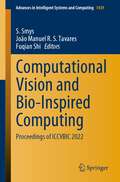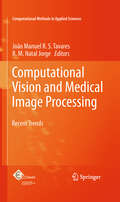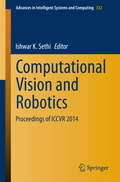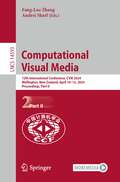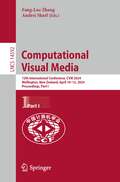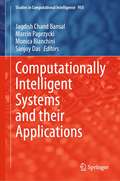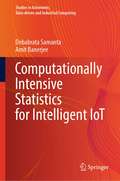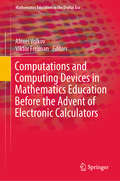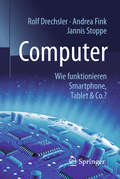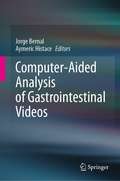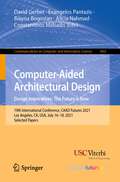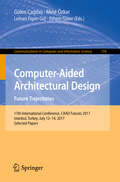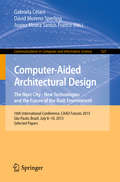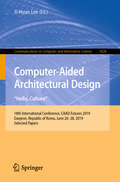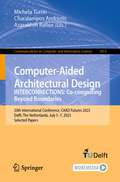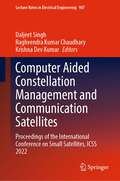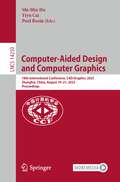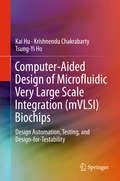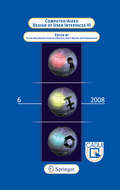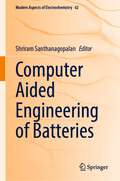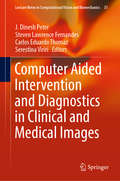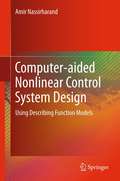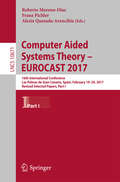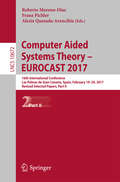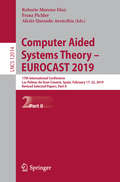- Table View
- List View
Computational Vision and Bio-Inspired Computing: Proceedings of ICCVBIC 2022 (Advances in Intelligent Systems and Computing #1439)
by S. Smys João Manuel R. S. Tavares Fuqian ShiThis book includes selected papers from the 6th International Conference on Computational Vision and Bio Inspired Computing (ICCVBIC 2022), held in Coimbatore, India, from November 18 to 19, 2022. This volume presents state-of-the-art research innovations in computational vision and bio-inspired techniques. It includes theoretical and practical aspects of bio-inspired computing techniques, like machine learning, sensor-based models, evolutionary optimization and big data modeling and management that make use of effectual computing processes in the bio-inspired systems.
Computational Vision and Medical Image Processing: Recent Trends (Computational Methods in Applied Sciences #19)
by Joao Tavares R. M. JorgeThis book contains extended versions of papers presented at the international Conference VIPIMAGE 2009 - ECCOMAS Thematic Conference on Computational Vision and Medical Image, that was held at Faculdade de Engenharia da Universidade do Porto, Portugal, from 14th to 16th of October 2009. This conference was the second ECCOMAS thematic conference on computational vision and medical image processing. It covered topics related to image processing and analysis, medical imaging and computational modelling and simulation, considering their multidisciplinary nature. The book collects the state-of-the-art research, methods and new trends on the subject of computational vision and medical image processing contributing to the development of these knowledge areas.
Computational Vision and Robotics: Proceedings of ICCVR 2014 (Advances in Intelligent Systems and Computing #332)
by Ishwar K. SethiComputer Vision and Robotic is one of the most challenging areas of 21st century. Its application ranges from Agriculture to Medicine, Household applications to Humanoid, Deep-sea-application to Space application, and Industry applications to Man-less-plant. Today's technologies demand to produce intelligent machine, which are enabling applications in various domains and services. Robotics is one such area which encompasses number of technology in it and its application is widespread. Computational vision or Machine vision is one of the most challenging tools for the robot to make it intelligent. This volume covers chapters from various areas of Computational Vision such as Image and Video Coding and Analysis, Image Watermarking, Noise Reduction and Cancellation, Block Matching and Motion Estimation, Tracking of Deformable Object using Steerable Pyramid Wavelet Transformation, Medical Image Fusion, CT and MRI Image Fusion based on Stationary Wavelet Transform. The book also covers articles from applications of soft computing techniques such as Target Searching and Tracking using Particle Swarm Optimization, PSO-based Functional Artificial Neural Network, etc. The book also covers article from the areas of Robotics such as Solar Power Robot Vehicle, Multi Robot Area Exploration, Intelligent Driving System based on Video Sequencing, Emotion Recognition using MLP Network, Identifying the Unstructured Environment.
Computational Visual Media: 12th International Conference, CVM 2024, Wellington, New Zealand, April 10–12, 2024, Proceedings, Part II (Lecture Notes in Computer Science #14593)
by Fang-Lue Zhang Andrei SharfThis book constitutes the refereed proceedings of CVM 2024, the 12th International Conference on Computational Visual Media, held in Wellington, New Zealand, in April 2024.The 34 full papers were carefully reviewed and selected from 212 submissions. The papers are organized in topical sections as follows:Part I: Reconstruction and Modelling, Point Cloud, Rendering and Animation, User Interations.Part II: Facial Images, Image Generation and Enhancement, Image Understanding, Stylization, Vision Meets Graphics.
Computational Visual Media: 12th International Conference, CVM 2024, Wellington, New Zealand, April 10–12, 2024, Proceedings, Part I (Lecture Notes in Computer Science #14592)
by Fang-Lue Zhang Andrei SharfThis book constitutes the refereed proceedings of CVM 2024, the 12th International Conference on Computational Visual Media, held in Wellington, New Zealand, in April 2024.The 34 full papers were carefully reviewed and selected from 212 submissions. The papers are organized in topical sections as follows:Part I: Reconstruction and Modelling, Point Cloud, Rendering and Animation, User Interations.Part II: Facial Images, Image Generation and Enhancement, Image Understanding, Stylization, Vision Meets Graphics.
Computationally Intelligent Systems and their Applications (Studies in Computational Intelligence #950)
by Jagdish Chand Bansal Marcin Paprzycki Monica Bianchini Sanjoy DasThis book covers all core technologies like neural networks, fuzzy systems, and evolutionary computation and their applications in the systems. Computationally intelligent system is a new concept for advanced information processing. The objective of this system is to realize a new approach for analyzing and creating flexible information processing of sensing, learning, recognizing, and action taking. Computational intelligent is a part of artificial intelligence (AI) which includes the study of versatile components to empower or encourage savvy practices in intricate and evolving situations. The computationally intelligent system highly relies on numerical information supplied by manufacturers unlike AI.
Computationally Intensive Statistics for Intelligent IoT (Studies in Autonomic, Data-driven and Industrial Computing)
by Debabrata Samanta Amit BanerjeeThe book covers computational statistics, its methodologies and applications for IoT device. It includes the details in the areas of computational arithmetic and its influence on computational statistics, numerical algorithms in statistical application software, basics of computer systems, statistical techniques, linear algebra and its role in optimization techniques, evolution of optimization techniques, optimal utilization of computer resources, and statistical graphics role in data analysis. It also explores computational inferencing and computer model's role in design of experiments, Bayesian analysis, survival analysis and data mining in computational statistics.
Computations and Computing Devices in Mathematics Education Before the Advent of Electronic Calculators (Mathematics Education in the Digital Era #11)
by Alexei Volkov Viktor FreimanThis volume traces back the history of interaction between the “computational” or “algorithmic” aspects of elementary mathematics and mathematics education throughout ages. More specifically, the examples of mathematical practices analyzed by the historians of mathematics and mathematics education who authored the chapters in the present collection show that the development (and, in some cases, decline) of counting devices and related computational practices needs to be considered within a particular context to which they arguably belonged, namely, the context of mathematics instruction; in their contributions the authors also explore the role that the instruments played in formation of didactical approaches in various mathematical traditions, stretching from Ancient Mesopotamia to the 20th century Europe and North America.
Computer: Wie funktionieren Smartphone, Tablet & Co.? (Technik im Fokus #3005)
by Rolf Drechsler Andrea Fink Jannis StoppeComputer umgeben uns heute in fast allen Lebensbereichen. Sie erleichtern uns nicht nur als PC oder Laptop die Arbeit, sondern sind auch eingebettet in zahlreiche Objekte unseres t#65533;glichen Lebens - vom Auto bis zur Waschmaschine. Doch wie funktionieren moderne Rechner eigentlich? Und wie werden diese hochkomplexen, aus Milliarden Komponenten bestehenden Ger#65533;te entworfen? Das Buch erkl#65533;rt auf verst#65533;ndliche, informative und unterhaltsame Weise den Aufbau und die Funktionsweise heutiger Computersysteme. Einzelne inhaltliche Abschnitte werden durch Links zu Videos erg#65533;nzt, in denen Professor Rolf Drechsler relevante Themen pr#65533;gnant und pointiert vorstellt.
Computer-Aided Analysis of Gastrointestinal Videos
by Jorge Bernal Aymeric HistaceThis book opens with an introduction to the main purpose and tasks of the GIANA challenge, as well as a summary and an analysis of the results and performance obtained by the 20 participating teams. The early and accurate diagnosis of gastrointestinal diseases is critical for increasing the chances of patient survival, and efficient screening is vital for locating precursor lesions. Video colonoscopy and wireless capsule endoscopy (WCE) are the gold-standard tools for colon and intestinal tract screening, respectively. Yet these tools still present some drawbacks, such as lesion miss rate, lack of in vivo diagnosis capabilities, and perforation risk. To mitigate these, computer-aided detection/diagnosis systems can play a key role in assisting clinicians in the different stages of the exploration.This book presents the latest, state-of-the-art approaches in this field, and also tackles the clinical considerations required to efficiently deploy these systems in the exploration room. The coverage draws upon results from the Gastrointestinal Image Analysis (GIANA) Challenge, part of the EndoVis satellite events of the conferences MICCAI 2017 and 2018. Each method proposed to address the different subtasks of the challenges is detailed in a separate chapter, offering a deep insight into this topic of interest for public health.This book appeals to researchers, practitioners, and lecturers spanning both the computer vision and gastroenterology communities.
Computer-Aided Architectural Design. Design Imperatives: 19th International Conference, CAAD Futures 2021, Los Angeles, CA, USA, July 16–18, 2021, Selected Papers (Communications in Computer and Information Science #1465)
by David Gerber Evangelos Pantazis Biayna Bogosian Alicia Nahmad Constantinos MiltiadisThis book constitutes selected papers of the 19th International Conference on Computer-Aided Architectural Design Futures, CAAD Futures 2021, held in Los Angeles, CA, USA, in July 2021.The 33 revised full papers presented were carefully reviewed and selected from 97 submissions. The papers are organized in topical sections on past futures and present futures: research and pedagogy; past futures and present futures: aesthetics and ethics of space; architectural automations and augmentations: design; architectural automations and augmentations: fabrication; architectural automations and augmentations: environment; architectural automations and augmentations: spatial computing.
Computer-Aided Architectural Design. Future Trajectories
by Gülen Çağdaş Mine Özkar Leman Figen Gül Ethem GürerThis book constitutes selected papers of the 17th International Conference on Computer-Aided Architectural Design Futures, CAAD Futures 2017, held in Istanbul, Turkey, in July 2017. The 22 revised full papers presented were carefully reviewed and selected from numerous submissions. The papers are organized in topical sections on modeling urban design; support systems for design decisions; studying design behavior in digital environments; materials, fabrication, computation; shape studies.
Computer-Aided Architectural Design Futures. The Next City - New Technologies and the Future of the Built Environment: 16th International Conference, CAAD Futures 2015, São Paulo, Brazil, July 8-10, 2015. Selected Papers (Communications in Computer and Information Science #527)
by Gabriela Celani David Moreno Sperling Juarez Moara Santos FrancoThis book constitutes the refereed proceedings of the 16th International Conference on Computer-Aided Architectural Design Futures, CAAD Futures 2015, held in São Paulo, Brazil, in July 2015. The 33 revised full papers presented were carefully reviewed and selected from 200 submissions. The papers are organized in topical sections on modeling, analyzing and simulating the city; sustainability and performance of the built space; automated and parametric design; building information modelling (BIM); fabrication and materiality; shape studies.
Computer-Aided Architectural Design. "Hello, Culture": 18th International Conference, CAAD Futures 2019, Daejeon, Republic of Korea, June 26–28, 2019, Selected Papers (Communications in Computer and Information Science #1028)
by Ji-Hyun LeeThis book constitutes selected papers of the 18th International Conference on Computer-Aided Architectural Design Futures, CAAD Futures 2019, held in Daejeon, Republic of Korea, in June 2019. The 34 revised full papers presented were carefully reviewed and selected from 194 submissions. The papers are organized in topical sections on theory, methodology and practice of architectural and interior design; support systems for design decisions; tools, methods and implementation of urban design; rethinking space and spatial behavior; fabrication and materialization; and shape studies.
Computer-Aided Architectural Design. INTERCONNECTIONS: 20th International Conference, CAAD Futures 2023, Delft, The Netherlands, July 5–7, 2023, Selected Papers (Communications in Computer and Information Science #1819)
by Michela Turrin Charalampos Andriotis Azarakhsh RafieeThis book includes the refereed Selected Papers of the 20th International Conference on Computer-Aided Architectural Design. INTERCONNECTIONS: Co-computing Beyond Boundaries, CAAD Futures 2023, held in Delft, The Netherlands, in July 5–7, 2023. The 43 full papers included in this book were carefully reviewed and selected from 144 submissions. They were organized in topical sections as follows: algorithmic architectural design; AI-powered architectural ideation; performance-based design, urban models and analysis; urban design; digital design, materials and fabrication; spatial information, data and semantics; building data analysis, visualisation, interaction; and building massing and layouts.
Computer Aided Constellation Management and Communication Satellites: Proceedings of the International Conference on Small Satellites, ICSS 2022 (Lecture Notes in Electrical Engineering #987)
by Krishna Dev Kumar Daljeet Singh Raghavendra Kumar ChaudharyThis book comprises the select proceedings of the International Conference on Small Satellites and its Applications (ICSS) 2022. It aims to provide a comprehensive and broad-spectrum picture of the state-of-the-art research, development, and commercial perspective of various discoveries conducted in the real-world smart small satellites, applications, and their services. The contents of this book focus on efficient power management systems, application-based optimum payload designs, telemetry and telecom and advanced navigation and RF systems, flight and ground software, structure, mechanism and materials, spacecraft autonomy, quality, testing and reliability for designing the small satellites through advanced computational procedures for a variety of applications, etc. This book proves to be a valuable resource for those in academia and industry.dgdg
Computer-Aided Design and Computer Graphics: 18th International Conference, CAD/Graphics 2023, Shanghai, China, August 19–21, 2023, Proceedings (Lecture Notes in Computer Science #14250)
by Shi-Min Hu Yiyu Cai Paul RosinThis book constitutes the proceedings of the CCF 18th International Conference on Computer-Aided Design and Computer Graphics, CAD/Graphics 2023, which took place in Shanghai, China, during August 19–21, 2023.The 23 full papers included in this book were carefully reviewed and selected from 169 submissions. They focus on topics such as computer graphics and CAD, 3D Printing and Computational Fabrication, 3D Vision, Bio-CAD and Nano-CAD, Computer Animation, Deep Learning for Graphics, Geometric Modeling, Geometry Processing, Rendering, Virtual Reality, Augmented Reality, Visualization, and more.
Computer-Aided Design of Microfluidic Very Large Scale Integration (mVLSI) Biochips: Design Automation, Testing, and Design-for-Testability
by Krishnendu Chakrabarty Tsung-Yi Ho Kai HuThis book provides a comprehensive overview of flow-based, microfluidic VLSI. The authors describe and solve in a comprehensive and holistic manner practical challenges such as control synthesis, wash optimization, design for testability, and diagnosis of modern flow-based microfluidic biochips. They introduce practical solutions, based on rigorous optimization and formal models. The technical contributions presented in this book will not only shorten the product development cycle, but also accelerate the adoption and further development of modern flow-based microfluidic biochips, by facilitating the full exploitation of design complexities that are possible with current fabrication techniques.
Computer-Aided Design of User Interfaces VI: Proceedings Of The Seventh International Conference On Computer-aided Design Of Users Inferaces (cadui 2008)
by Victor Lopez Jaquero Francisco Montero Simarro Jean Vanderdonckt Jose Pascual Molina MassoComputer-Aided Design of User Interfaces VI gathers the latest experience of experts, research teams and leading organisations involved in computer-aided design of user interactive applications. This area investigates how it is desirable and possible to support, to facilitate and to speed up the development life cycle of any interactive system: requirements engineering, early-stage design, detailed design, deelopment, deployment, evaluation, and maintenance. In particular, it stresses how the design activity could be better understood for different types of advanced interactive ubiquitous computing, and multi-device environments.
Computer Aided Engineering of Batteries (Modern Aspects of Electrochemistry #62)
by Shriram SanthanagopalanThis edited volume, with contributions from the Computer Aided Engineering for Batteries (CAEBAT) program, provides firsthand insights into nuances of implementing battery models in actual geometries. It discusses practical examples and gaps in our understanding, while reviewing in depth the theoretical background and algorithms. Over the last ten years, several world-class academics, automotive original equipment manufacturers (OEMs), battery cell manufacturers and software developers worked together under an effort initiated by the U.S. Department of Energy to develop mature, validated modeling tools to simulate design, performance, safety and life of automotive batteries. Until recently, battery modeling was a niche focus area with a relatively small number of experts. This book opens up the research topic for a broader audience from industry and academia alike. It is a valuable resource for anyone who works on battery engineering but has limited hands-on experience with coding.
Computer Aided Intervention and Diagnostics in Clinical and Medical Images (Lecture Notes in Computational Vision and Biomechanics #31)
by J. Dinesh Peter Steven Lawrence Fernandes Carlos Eduardo Thomaz Serestina ViririThis book is a compendium of the ICCMIA 2018 proceedings, which provides an ideal reference for all medical imaging researchers and professionals to explore innovative methods and analyses on imaging technologies for better prospective patient care.This work serves as an exclusive source for new computer assisted clinical and medical developments in imaging diagnosis, intervention and analysis. It includes articles on computer assisted medical scanning techniques, computer-aided diagnosis, robotic surgery and imaging, imaging genomics, clinically-oriented imaging physics and informatics, augmented-reality medical visualization, imaging modalities, computerized radiology, oncology, and surgery. Moreover, information on non-medical imaging that has medical applications such as multi-photon microscopy and confocal, photoacoustic imaging, optical microendoscope, infra-red radiation, and other imaging modalities is also represented.
Computer-aided Nonlinear Control System Design: Using Describing Function Models
by Amir NassirharandA systematic computer-aided approach provides a versatile setting for the control engineer to overcome the complications of controller design for highly nonlinear systems. Computer-aided Nonlinear Control System Design provides such an approach based on the use of describing functions. The text deals with a large class of nonlinear systems without restrictions on the system order, the number of inputs and/or outputs or the number, type or arrangement of nonlinear terms. The strongly software-oriented methods detailed facilitate fulfillment of tight performance requirements and help the designer to think in purely nonlinear terms, avoiding the expedient of linearization which can impose substantial and unrealistic model limitations and drive up the cost of the final product. Design procedures are presented in a step-by-step algorithmic format each step being a functional unit with outputs that drive the other steps. This procedure may be easily implemented on a digital computer with example problems from mechatronic and aerospace design being used to demonstrate the techniques discussed. The author's commercial MATLAB®-based environment, available separately from insert URL here, can be used to create simulations showing the results of using the computer-aided control system design ideas characterized in the text. Academic researchers and graduate students studying nonlinear control systems and control engineers dealing with nonlinear plant, particularly mechatronic or aerospace systems will find Computer-aided Nonlinear Control System Design to be of great practical assistance adding to their toolbox of techniques for dealing with system nonlinearities. A basic knowledge of calculus, nonlinear analysis and software engineering will enable the reader to get the best from this book.
Computer Aided Systems Theory – EUROCAST 2017: 16th International Conference, Las Palmas de Gran Canaria, Spain, February 19-24, 2017, Revised Selected Papers, Part I (Lecture Notes in Computer Science #10671)
by Roberto Moreno-Díaz Franz Pichler Alexis Quesada-ArencibiaThe two-volume set LNCS 10671 and 10672 constitutes the thoroughly refereed proceedings of the 16th International Conference on Computer Aided Systems Theory, EUROCAST 2017, held in Las Palmas de Gran Canaria, Spain, in February 2017. The 117 full papers presented were carefully reviewed and selected from 160 submissions. The papers are organized in topical sections on: pioneers and landmarks in the development of information and communication technologies; systems theory, socio-economic systems and applications; theory and applications of metaheuristic algorithms; stochastic models and applications to natural, social and technical systems; model-based system design, verification and simulation; applications of signal processing technology; algebraic and combinatorial methods in signal and pattern analysis; computer vision, deep learning and applications; computer and systems based methods and electronics technologies in medicine; intelligent transportation systems and smart mobility.
Computer Aided Systems Theory – EUROCAST 2017: 16th International Conference, Las Palmas de Gran Canaria, Spain, February 19-24, 2017, Revised Selected Papers, Part II (Lecture Notes in Computer Science #10672)
by Roberto Moreno-Díaz Franz Pichler Alexis Quesada-ArencibiaThe two-volume set LNCS 10671 and 10672 constitutes the thoroughly refereed proceedings of the 16th International Conference on Computer Aided Systems Theory, EUROCAST 2017, held in Las Palmas de Gran Canaria, Spain, in February 2017. The 117 full papers presented were carefully reviewed and selected from 160 submissions. The papers are organized in topical sections on: pioneers and landmarks in the development of information and communication technologies; systems theory, socio-economic systems and applications; theory and applications of metaheuristic algorithms; stochastic models and applications to natural, social and technical systems; model-based system design, verification and simulation; applications of signal processing technology; algebraic and combinatorial methods in signal and pattern analysis; computer vision, deep learning and applications; computer and systems based methods and electronics technologies in medicine; intelligent transportation systems and smart mobility.
Computer Aided Systems Theory – EUROCAST 2019: 17th International Conference, Las Palmas de Gran Canaria, Spain, February 17–22, 2019, Revised Selected Papers, Part II (Lecture Notes in Computer Science #12014)
by Roberto Moreno-Díaz Franz Pichler Alexis Quesada-ArencibiaThe two-volume set LNCS 12013 and 12014 constitutes the thoroughly refereed proceedings of the 17th International Conference on Computer Aided Systems Theory, EUROCAST 2019, held in Las Palmas de Gran Canaria, Spain, in February 2019. The 123 full papers presented were carefully reviewed and selected from 172 submissions. The papers are organized in the following topical sections: Part I: systems theory and applications; pioneers and landmarks in the development of information and communication technologies; stochastic models and applications to natural, social and technical systems; theory and applications of metaheuristic algorithms; model-based system design, verification and simulation. Part II: applications of signal processing technology; artificial intelligence and data mining for intelligent transportation systems and smart mobility; computer vision, machine learning for image analysis and applications; computer and systems based methods and electronic technologies in medicine; advances in biomedical signal and image processing; systems concepts and methods in touristic flows; systems in industrial robotics, automation and IoT.
